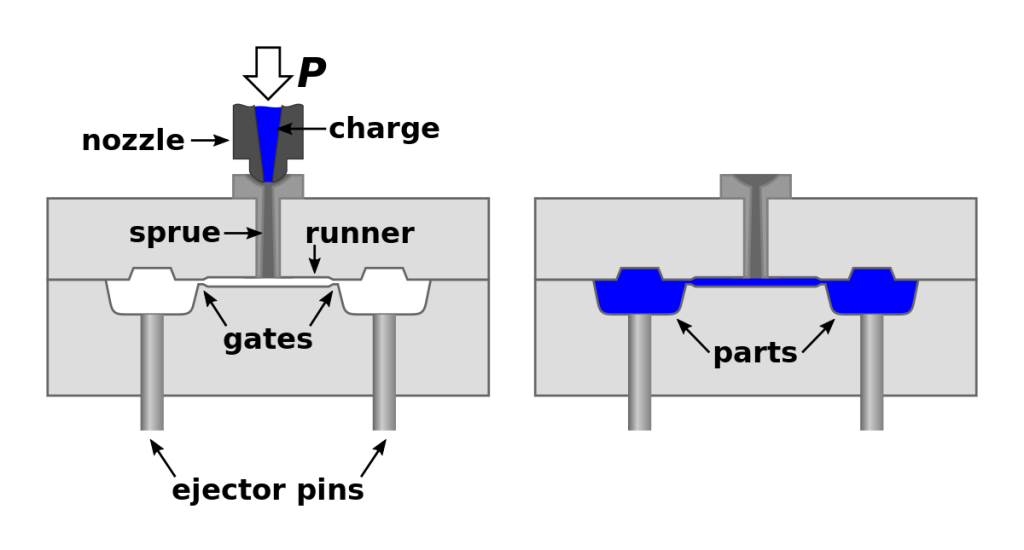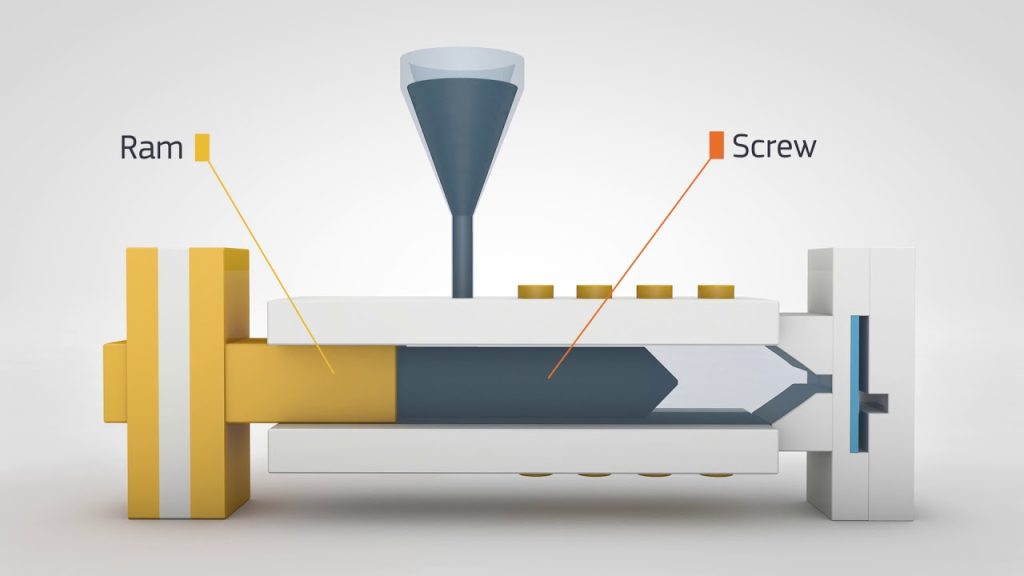Have you ever wondered how plastic products are made? Injection molding is a popular manufacturing process used to produce a wide range of plastic products, from toys to car parts. In this article, we will take a detailed look at the step-by-step injection molding process and learn how it works.
From designing the mold to injecting the plastic material, each step of the injection molding process requires precision and expertise. Understanding the process can help you appreciate the complexity of the manufacturing world and appreciate the plastic products you use every day. So let’s dive in and explore the fascinating world of injection molding!
What is the Step by Step Injection Molding Process?
Injection molding is a manufacturing process that involves melting plastic pellets and injecting them into a mold to create a product. The process is used to produce a wide range of products, including toys, automotive parts, and medical devices. The step by step injection molding process involves several stages, each of which is critical to the success of the final product.
Stage 1: Clamping
The first stage of the injection molding process is clamping. During this stage, the mold is held tightly closed by a clamping unit. The clamping force is determined by the size and shape of the mold, as well as the material being used. The goal of this stage is to ensure that the mold does not open during the injection process.
Once the mold is clamped, the material is injected into the mold through a nozzle. The material is typically heated to a temperature that allows it to flow easily into the mold. The amount of material injected into the mold is controlled by the injection unit.
Stage 2: Injection
The second stage of the injection molding process is injection. During this stage, the material is injected into the mold through a nozzle. The material is typically heated to a temperature that allows it to flow easily into the mold. The amount of material injected into the mold is controlled by the injection unit.
Once the material is injected into the mold, it is cooled and solidified. The cooling time depends on the size and shape of the part being produced, as well as the material being used. Once the part is cooled, the mold is opened and the part is ejected.
Stage 3: Cooling
The third stage of the injection molding process is cooling. During this stage, the part is cooled and solidified. The cooling time depends on the size and shape of the part being produced, as well as the material being used.
There are several factors that can affect the cooling time, including the material being used, the temperature of the mold, and the design of the part. To ensure that the part is properly cooled and solidified, it is important to carefully monitor the cooling process.
Stage 4: Ejection
The fourth stage of the injection molding process is ejection. During this stage, the mold is opened and the part is ejected. The ejection process is typically performed by an ejector pin, which pushes the part out of the mold.
It is important to ensure that the part is properly ejected from the mold to avoid damage or defects. The ejection process should be carefully monitored to ensure that the part is ejected smoothly and without any issues.
Stage 5: Sprue Removal
The fifth stage of the injection molding process is sprue removal. During this stage, the sprue, which is the excess material that is attached to the part, is removed. This process is typically performed by a trimmer, which cuts the sprue off of the part.
It is important to remove the sprue properly to avoid damaging the part. The sprue should be removed cleanly and without any burrs or rough edges.
Stage 6: Secondary Operations
The sixth stage of the injection molding process is secondary operations. During this stage, any additional operations that are required to finish the part are performed. This may include drilling, tapping, or painting.
It is important to carefully plan for any secondary operations to ensure that they are performed correctly and do not damage the part. The secondary operations should be performed in a controlled environment to minimize the risk of contamination.
Stage 7: Inspection
The seventh stage of the injection molding process is inspection. During this stage, the part is inspected to ensure that it meets the required specifications. This may include dimensional checks, visual inspections, and functional testing.
It is important to perform thorough inspections to ensure that the part is of high quality and meets the required standards. Any defects or issues should be identified and addressed as soon as possible.
Stage 8: Packaging
The eighth stage of the injection molding process is packaging. During this stage, the parts are packaged and prepared for shipping. This may include labeling, bagging, or boxing the parts.
It is important to carefully package the parts to ensure that they are protected during shipping and arrive at their destination in good condition.
Stage 9: Benefits of Injection Molding
Injection molding offers several benefits over other manufacturing processes, including:
- High production rates
- Low labor costs
- Ability to produce complex parts
- Consistent part quality
- Low scrap rates
Stage 10: Injection Molding vs Other Manufacturing Processes
Injection molding is often compared to other manufacturing processes, such as machining, casting, and extrusion. While each process has its own advantages and disadvantages, injection molding offers several benefits, including:
| Process | Advantages | Disadvantages |
|---|---|---|
| Injection Molding | High production rates Low labor costs Ability to produce complex parts Consistent part quality Low scrap rates |
High initial tooling costs Not suitable for small production runs |
| Machining | Can produce a wide range of shapes and sizes High precision Low material waste |
High labor costs Slow production rates Not suitable for complex shapes |
| Casting | Low tooling costs Can produce large parts Low material waste |
Slow production rates Not suitable for complex shapes Limited part strength |
| Extrusion | Low tooling costs High production rates Can produce long parts |
Not suitable for complex shapes Limited part strength High material waste |
Overall, injection molding is a highly efficient and reliable manufacturing process that offers several benefits over other processes. By understanding the step by step injection molding process, manufacturers can ensure that they produce high-quality parts that meet their customers’ requirements.
Frequently Asked Questions
Injection molding is a widely used manufacturing process for producing plastic parts in large quantities. It involves a series of steps that are carefully followed to ensure quality and consistency. Here are some commonly asked questions about the step-by-step injection molding process:
What is the first step in the injection molding process?
The first step in the injection molding process is to create a mold. The mold is designed to the exact specifications of the part that is being produced. It is typically made of steel and consists of two halves that fit together to form a cavity. Once the mold is created, it is mounted onto the injection molding machine.
The injection molding machine then heats the plastic material until it is melted and injects it into the mold. The plastic material fills the cavity and takes on the shape of the mold. This process is known as the injection phase.
What happens after the injection phase?
After the injection phase, the mold is cooled to solidify the plastic material. This is known as the cooling phase. The cooling time can vary depending on the type of plastic material and the size and shape of the part being produced. Once the plastic material has solidified, the mold is opened and the part is ejected from the mold.
The part is then inspected for any defects such as warping or sink marks. If there are no defects, the part is ready for use. If there are defects, the mold may need to be adjusted or repaired before the next production run.
What are some factors that can affect the injection molding process?
There are several factors that can affect the injection molding process. These include the type of plastic material being used, the design of the mold, the injection molding machine settings, and the environmental conditions such as temperature and humidity. It is important to carefully control these factors to ensure consistent and high-quality production.
In addition, the injection molding process can be affected by any contaminants in the plastic material or mold. To prevent this, the injection molding machine and mold must be properly maintained and cleaned on a regular basis.
What are some advantages of the injection molding process?
The injection molding process offers several advantages over other manufacturing processes. One of the biggest advantages is the ability to produce large quantities of high-quality parts quickly and efficiently. The process is also highly automated, which helps to reduce labor costs and increase productivity.
Another advantage is the ability to produce complex parts with a high degree of accuracy and consistency. This is because the mold can be designed to the exact specifications of the part being produced. Additionally, the injection molding process is highly versatile and can be used to produce a wide range of parts in various sizes and shapes.
What are some common applications of the injection molding process?
The injection molding process is used in a wide range of industries to produce a variety of plastic parts. Some common applications include automotive parts, medical devices, consumer products, electronic components, and toys. The process is also used to produce packaging materials such as bottles, caps, and containers.
Overall, the injection molding process is a highly efficient and effective way to produce high-quality plastic parts in large quantities. By carefully controlling the various factors involved in the process, manufacturers can ensure consistent and reliable production of a wide range of products.
In conclusion, the injection molding process is a highly efficient and cost-effective method of manufacturing plastic products. By using a step-by-step approach, manufacturers can ensure that each stage of the process is executed with precision and accuracy, resulting in high-quality products that meet the exact specifications of their customers.
The first step in the injection molding process is the creation of a mold or tool. This is typically done using computer-aided design (CAD) software and can take anywhere from a few hours to several days, depending on the complexity of the design. Once the mold is created, it is loaded into the injection molding machine, and the plastic material is injected into the mold cavity.
Next, the mold is cooled to allow the plastic to solidify and take on the shape of the mold. This is a critical step in the process, as it ensures that the final product will be free of defects and have the desired physical properties. Finally, the finished product is ejected from the mold and sent to be inspected and packaged for shipment.
Overall, the injection molding process is a highly effective way to manufacture plastic products quickly and efficiently. By following a step-by-step approach, manufacturers can produce high-quality products that meet the exact needs of their customers. Whether you are looking to produce simple parts or complex assemblies, injection molding is a versatile and reliable manufacturing process that can help you achieve your goals.
Request a quote today!
[contact-form-7 id="1578" title="Contact form"]
Please compress the file into a ZIP or RAR file before uploading. Alternatively, send through your RFQ by email.
enquires@unitymanufacture.com





